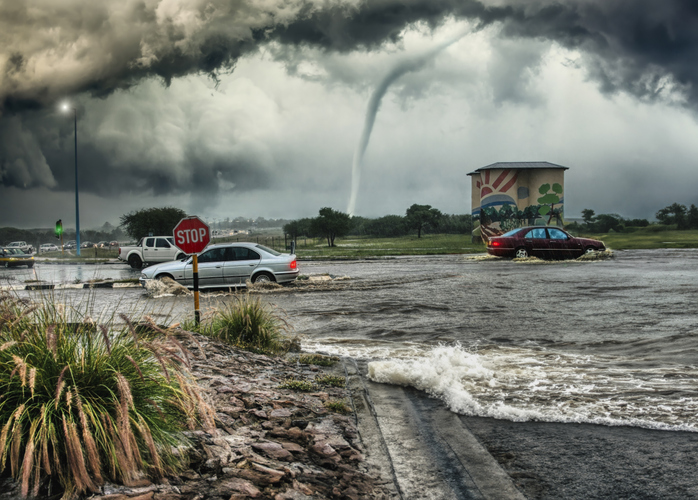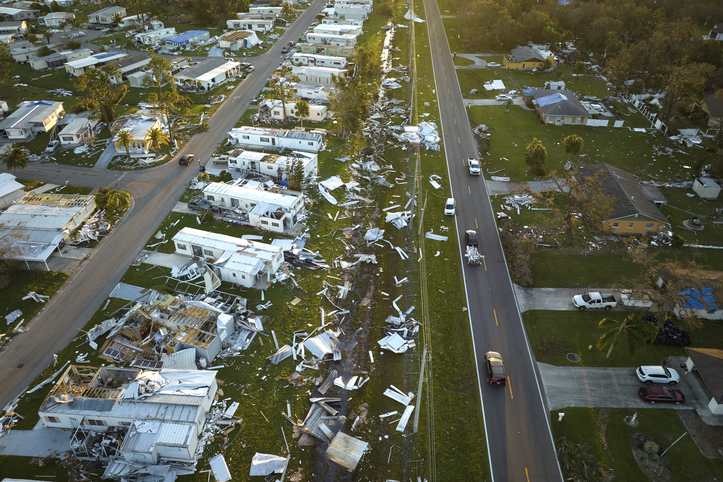The Short Answer: Hurricanes inflict massive property damage across the United States, with recent annual costs averaging $150 billion from wind damage, storm surge flooding, and inland flooding. These powerful storms can destroy homes, businesses, and infrastructure in a matter of hours, affecting millions of properties along the Atlantic and Gulf coasts each year.
When a hurricane makes landfall, it brings multiple threats that can devastate properties. From Category 1 to Category 5 storms, hurricanes unleash destructive forces that damage roofs, shatter windows, flood buildings, and sometimes completely destroy structures. Understanding the scale of hurricane property damage helps property owners prepare for these events and take action to protect their investments.
Hurricanes unleash devastating impacts on properties, with costs varying dramatically across regions and storm categories. From structural damage to flooding, these powerful storms pose serious threats to homes and businesses in vulnerable coastal areas. Understanding the scope of hurricane destruction helps property owners prepare for and respond to these natural disasters effectively.
The Scale of Hurricane Property Damage
Hurricanes rank among the most destructive natural disasters in the United States, causing devastating hurricane damage that has grown more severe in recent years. The annual economic damage from hurricanes in the United States averages $150 billion a year, with seven of the ten most billion-dollar weather disasters occurring since 2005. Hurricane Katrina remains the costliest storm in U.S. history at $201 billion in total damage, followed closely by Hurricane Harvey in 2017 with $160 billion.
The destruction touches every type of property in affected coastal areas. For residential areas, hurricanes cause wind damage to roofs, shatter windows, and create flood damage – often making them uninhabitable for months. In addition to residential homes, commercial properties suffer structural damage plus major business interruption costs, with shopping centers, hotels, and office buildings often requiring extensive damage assessment reaching into millions of dollars.

Property Damage by Category
- Category 1: Roof damage, broken windows, moderate flooding – typically affecting 1.3 million homes. Reconstruction costs average $396 billion.
- Category 2: Similar moderate damage to structures and flooding – 2.8 million homes affected and $875 billion in reconstruction costs.
- Category 3: Structural damage to houses, destroyed mobile homes, widespread flooding – 4.6 million homes affected and $1.4 trillion in damage.
- Category 4: Catastrophic damage (collapsed buildings, total loss) – 6.6 million homes affected and $2.042 trillion in damage.
- Category 5: Extreme widespread destruction – 7.7 million homes affected and $2.343 trillion in damage.
The geographic impact concentrates along the Atlantic and Gulf Coast, with Florida, Texas, Louisiana, and North Carolina experiencing the highest frequency of hurricane strikes and storm damage. Low-lying areas face the most severe effects, but hurricane damage often extends hundreds of miles inland through flooding and tornado spawning. Urban areas see amplified damage costs due to their dense development and expensive infrastructure, while rural regions struggle with agricultural losses and damaged utility systems.
Recent years have shown concerning trends as climate change makes hurricanes stronger and sea levels rise. Storm surge now reaches further inland, threatening previously safe areas. Combined with increasing coastal development, this has led to record-breaking damage estimates that continue to climb with each hurricane season.
Common Types of Hurricane Damage
Hurricanes inflict substantial damage through multiple destructive forces, with sustained winds reaching up to 157 mph in Category 5 storms and storm surge exceeding 20 feet in height. Understanding these damage mechanisms helps property owners prepare for and respond to hurricane threats in coastal areas.
Wind Damage Patterns
High winds during hurricanes attack buildings from multiple angles, often starting with wind damage to the roof. Shingles and tiles frequently tear away first, exposing the underlying structure. Once winds penetrate the roof covering, they can lift entire sections, creating a chain reaction of structural stress. Windows and doors face intense pressure from these tropical storm winds, with broken windows allowing destructive internal pressure to build up inside homes. Flying debris – from tree branches to outdoor furniture – becomes dangerous projectiles that shatter windows and damage siding.
Water-Related Destruction
Storm surge ranks among the most devastating elements of hurricane damage, pushing walls of seawater inland that can demolish buildings through sheer force. These surges can reach up to 20 feet, causing flood damage in low-lying areas well beyond the coast. Rainfall adds another layer of total damage, with some tropical cyclones dumping over 20 inches in 24 hours. This intense rainfall overwhelms drainage systems, seeps through damaged roofs, and can flood homes from both above and below.
Structural and Secondary Effects
The combined assault of wind and water often leads to economic damage, particularly when flood waters erode the soil beneath buildings. Wall failures typically occur at weak points where utilities enter the structure or around poorly secured doors and windows. Beyond immediate storm damage, hurricanes create perfect conditions for mold growth, with humid conditions and standing water fostering extensive microbial problems within 48-72 hours after the storm passes.
Prevention and Protection Measures
Building reinforcement plays a major role in reducing hurricane damage to properties. Hurricane straps, made of galvanized steel, connect roof trusses to wall frames, significantly reducing the risk of roof separation during high winds. Impact-resistant windows feature specialized glazing that prevents storm damage from wind-borne debris, while roof tie-downs provide additional structural support against wind damage and uplift forces.
Before hurricane season begins, property owners should complete several preparatory steps. Start by trimming trees and removing dead branches that could become projectiles during tropical storms. Clean gutters and downspouts to prevent water backup, and install or check backwater valves to protect against sewage backup. Take photos and videos of your property’s current condition, including close-ups of valuable items and structural elements.
When a storm approaches, secure outdoor furniture, toys, and decorations. Board up windows if you don’t have impact-resistant glass. Stock up on emergency supplies including water, non-perishable food, batteries, and first-aid materials. Keep important documents in waterproof containers, including:
- Property deed and insurance policies
- Recent property photos and videos
- List of valuable items with serial numbers
- Contact information for the insurance company and restoration services
Insurance protection requires careful attention to detail. Most standard homeowner’s policies don’t cover flood damage, so a separate flood insurance policy is often necessary in hurricane-prone areas. Wind damage coverage varies by region and policy type. Document all pre-storm protection measures you’ve taken, as many insurance companies offer discounts for hurricane mitigation features. After a storm, photograph all damage immediately and keep receipts for any emergency repairs to support your claim.
Post-Hurricane Recovery Assistance
Immediate Emergency Response
After a hurricane strikes, the first 24-48 hours are most critical for storm damage assessment. Contact RestoPros to conduct a thorough damage assessment to check structural stability, power outage risks, and flood damage concerns. Keep these emergency contacts ready: local fire department, utility companies, insurance company, and professional restoration services.
Professional Restoration Services
RestoPros rapid response teams arrive quickly with industrial-grade equipment to begin hurricane damage recovery. Our IICRC-certified technicians perform comprehensive damage assessments and create detailed restoration plans. The team works efficiently to:
- Remove standing water
- Dry affected areas
- Prevent mold growth
- Restore damaged materials
- Clean and sanitize
Insurance Claims Process
Document all hurricane damage immediately through photos and videos before any cleanup begins. Create detailed damage estimates, including purchase dates and estimated values. Contact your insurance company right away to start the claims process. When the insurance adjuster arrives, they’ll need:
- Photos and videos of all damage
- List of damaged belongings
- Receipts for emergency repairs
- Restoration company estimates
- Timeline of events
Government Aid Programs
After substantial damage from hurricanes, multiple federal agencies provide assistance programs to help affected coastal areas recover. The Federal Emergency Management Agency provides crucial support through emergency shelter assistance, property damage coverage, essential needs funding, and emergency repairs. The Small Business Administration (SBA) offers disaster loans featuring low-interest options for repairs, replacement of damaged property, and working capital for impacted businesses.
Additionally, state-level recovery efforts, which vary by different locations, typically provide emergency housing assistance, debris removal help, crisis counseling, and unemployment assistance for those affected by natural disasters. These comprehensive aid programs work together to help communities rebuild and recover in the aftermath of devastating hurricanes.
Measuring the Impact of Property Damage
Hurricanes consistently rank among the most destructive climate disasters, causing billions in economic damage annually through devastating combinations of wind damage, storm surge, and flooding. These tropical storms can impact homes and businesses for months or even years after they pass, with damage ranging from minor roof issues to complete structural failure. While we can’t prevent hurricanes, taking proactive steps like maintaining proper flood insurance, installing storm shutters, and having an emergency plan can significantly reduce potential losses.
When storms strike, having a trusted restoration partner makes all the difference in protecting your property and peace of mind. RestoPros offers 24/7 emergency response for hurricane damage, with experienced teams ready to handle everything from water extraction to structural repairs. Our professional restoration services help minimize secondary damage and get your property back to normal as quickly as possible. Don’t wait until it’s too late – contact RestoPros today, and contact us at the first sign of storm damage.



